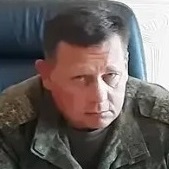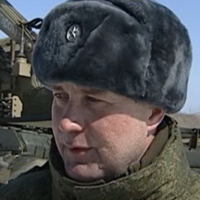In early spring 1944, when the Soviet army began to draw nearer to the occupied Kherson, the Nazis, who were very interested in the history of southern Ukraine and the Gothic period in particular, decided to take away valuable museum exhibits. This was a common practice during the World War II. The stolen items included artifacts from the Bronze Age collection The Bronze Age on the territory of modern Ukraine dates back to approximately 3000 to late 2000 BC), found during excavations in the Kherson region. The Nazis, under the supervision of German scientists, took away many tools: axes, axe blanks, etc.
‘Why did the Nazis do all this? Not only to enrich their country, although this was also one of their goals. They also took those valuables – Jewish, Ukrainian, and Polish – to show that they were a powerful empire, that they were an Aryan race that owned the world not only materially but also culturally and spiritually. Russia thinks the same way”, explains historian Yaroslava Muzychenko.
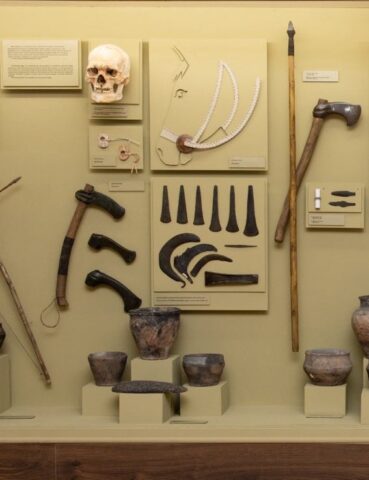
A part of the collection of Bronze Age objects kept in the Kherson Regional Museum of Local Lore (photo courtesy of Olha Honcharova)
In the early 1990s, when Ukraine had already become an independent state, research on these bronze objects was conducted in Germany. At that time, scientists paid attention to their markings, which indicated their origin: Kherson Museum of Local Lore. After lengthy negotiations between the governments of the two countries, in 1994 the stolen artefacts were finally returned home and added to the exhibition on the history of the Kherson region.
However, when the Russian occupiers were fleeing Kherson in the autumn of 2022, they robbed the Kherson Regional Museum of Local Lore again, also stealing the ill-fated bronze collection.
***
Today, more than 18% of Ukraine’s territory is under Russian occupation according to DeepState. However, it is not only land, natural resources, settlements and people, but also Ukrainian cultural heritage: architectural monuments, museum collections and exhibits.
For the Russians, the theft of golden Scythian jewellery, bronze and copper tools, ancient rifles and paintings from museums is not so much about enrichment as it is about appropriating Ukrainian culture and history. The example of Kherson, which we will describe below, shows that depriving Ukrainians of their cultural heritage is a deliberate and organised effort by Russians. Specific people are to blame for this – the military who gave and executed orders, the scholars who advised them, the officials who organised and controlled the process, and, of course, the Ukrainian collaborators who helped them.
NGL.media identified the vast majority of these people.
Treasure Island
According to the Ministry of Culture, Ukraine’s museum collection currently includes about 12,000,000 exhibits, of which more than 1,400,000 items are under occupation or stolen. It’s a huge number, and although it’s not customary to talk about it out loud, the chances of getting back what was taken are quite remote.
The occupation of Kherson, whose museums housed large collections of historical artefacts from the Northern Black Sea region, paintings, and unique local nature exhibits, lasted from 2 March to 11 November 2022. When Russian troops were retreating, they destroyed the main infrastructure of Kherson, left the inhabitants without water and electricity, blew up a dozen bridges, and took thousands of museum exhibits.
Russians believe that the southern cities of Ukraine, such as Odesa and Kherson, appeared on the world map thanks to the figures of the Russian Empire in the 18th century: Catherine the Great, Potemkin, Suvorov and others, and therefore are ‘native Russian lands’. Therefore, they are interested not only in the physical seizure of these lands, but also in appropriating their cultural heritage.
When fleeing Kherson, the Russian military apparently received instructions to take with them as much cultural property and documents as possible from the city’s two main museums – the Kherson Regional Art Museum Kherson Regional Art Museum named after Oleksii Shovkunenko is located in the building of the former city hall. Prior to the Russian invasion, the museum’s collection included more than 13,000 works of art and was considered one of the most interesting art collections in Ukraine. The museum had on display Ukrainian and foreign paintings, graphics, sculpture, and decorative and applied arts, ranging from 17th-century iconography to works by contemporary Kherson artists) and the Kherson Regional Museum of Local Lore The Kherson Regional Museum of Local Lore is housed in several buildings in Kherson and has a branch museum in occupied Kakhovka. The museum’s collections had more than 170,000 artefacts, including collections of archaeological finds, ancient coins from the Northern Black Sea region, antique weapons, antique furniture, etc. The museum also boasts a unique natural history collection, which was started in the late 19th century by biologist Joseph Pachosky. The 26-metre-long whale skeleton is the most famous exhibit in this department. It survived despite being damaged during the 2022 hostilities.
NGL.media found out that he robbery of these two museums took place a few days before the liberation of Kherson, in late October – early November 2022. The Russians who directly stole the artefacts were mostly wearing military uniforms without any insignia of specific units. They deliberately hid their faces behind balaclavas, making their identification extremely difficult. However, international humanitarian law Rule 153 of Customary International Humanitarian Law states that commanders and other superiors are criminally responsible for war crimes committed by their subordinates and resulting from the orders they give.
The Russian servicemen who attacked and occupied Kherson are representatives of the 7th Air Assault and 42nd Motorised Rifle Divisions, which are part of the 58th Combined Arms Army of the Southern Military District of the Russian Federation.
Almost two years have passed since Kherson museums were robbed. However, eyewitnesses are still reliving those events. Alina Dotsenko, 74, director of the Kherson Regional Art Museum, was the focus of Western journalists’ attention immediately after the deoccupation of Kherson. She gave emotional interviews, unable to hold back her tears and disgust at her colleagues who had collaborated with the enemy.
The woman’s emotions have not yet subsided. We talk to her online for several hours, and during the conversation, Alina Dotsenko raises her voice, talking about Russians and collaborators, and bitterly tells us about her favourite paintings that her museum has lost.
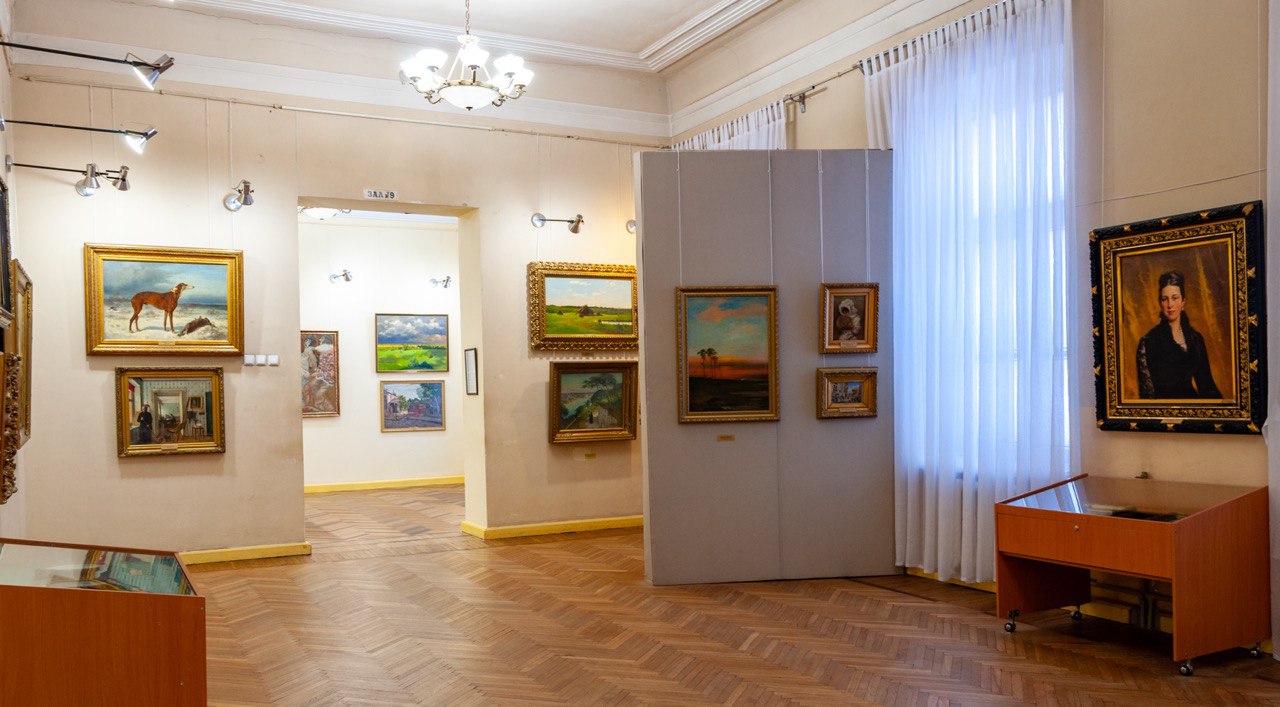
The Kherson Regional Art Museum had a collection of artworks of the 17th – 21st centuries (photo by Alina Dotsenko)
“Shortly before the invasion, we received a letter from the [Kherson] regional council asking us to remove the collections from the second and third floors so that repair work could begin there at the time of the invasion, the Kherson Regional Art Museum was undergoing restoration work as part of the Presidential programme “Big Restoration”). We bought packing material on our own and moved the collections to a storage facility… And on 24 February, we had a call with Tkachenko Oleksandr Tkachenko, Minister of Culture of Ukraine in 2020-2023. And he told us to evacuate the collections immediately. How? Where to? Where could we get transport? I couldn’t find a car to get from my own house to the museum, and where could I get six or seven trucks to take out all the exhibits? There were only women among our employees. It was an unrealistic task,” Alina Dotsenko recalls.
Being unable to take the collection to a safe place, the museum staff hoped that the Russians, seeing the empty shelves and the repairs underway, would not think to go down to the storage facility. Alina Dotsenko asked her subordinates to lie to the occupiers that she had personally taken the entire museum collection out before they arrived, and that the storage facility was empty. But some of the employees turned out to be supporters of the occupation, so the information about the hidden valuables eventually reached the Russians.
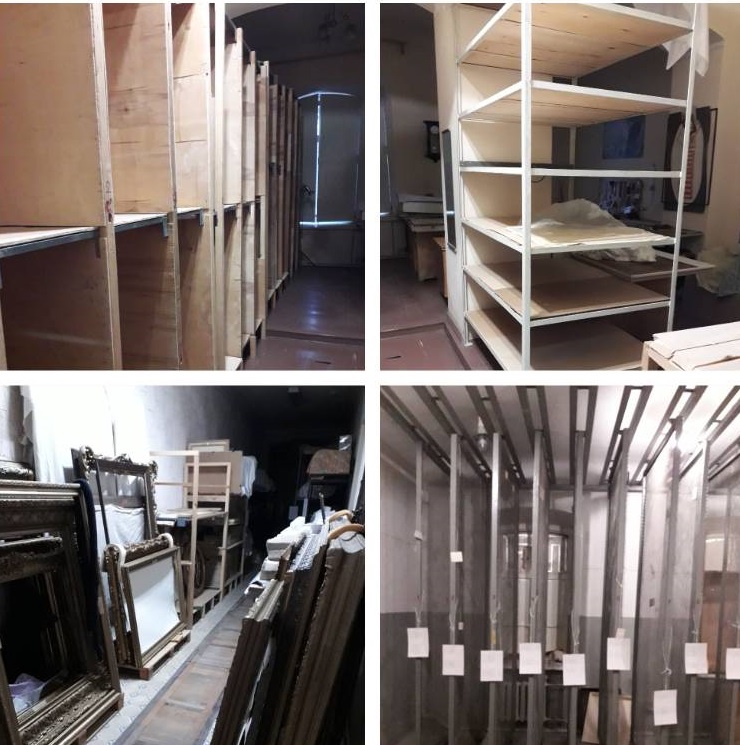
The Russians took almost all the artworks from the art museum, leaving empty frames and shelves (photo by Alina Dotsenko)
‘On 4 May, in the evening, I received a call from an unknown man who introduced himself as a representative of the new administration. At first he threatened me, and then offered to organize an exhibition by 9 May Russian Victory Day, on this day a number of occupied museums held and still hold thematic exhibitions dedicated to the arrival of the Soviet army on these lands during World War II. I told him that I couldn’t help him because I had evacuated the entire collection. He said that he had already been informed that the collection was still there, and summoned me to the commandant’s office to ‘teach me to respect the new government’. I had to leave Kherson urgently the same night,” recalls Alina Dotsenko.
The most famous artworks stolen by Russians
(click on the image to view it in full size)
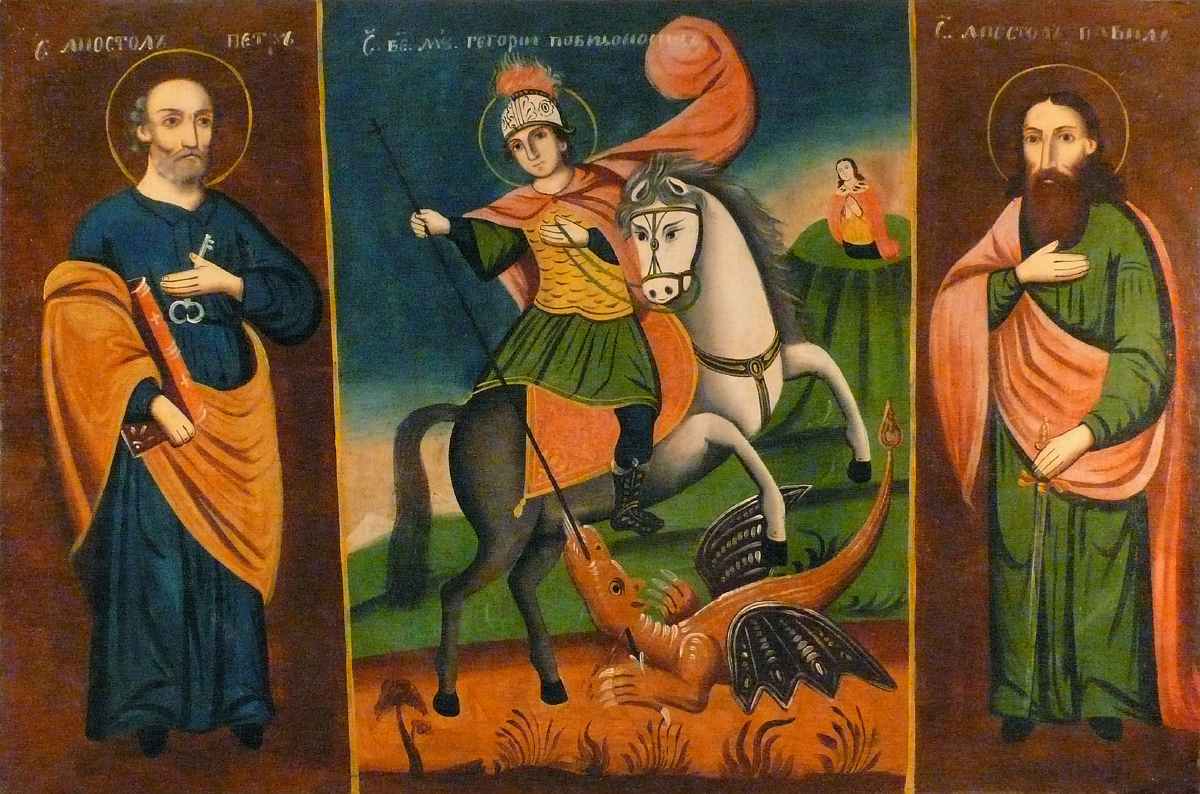
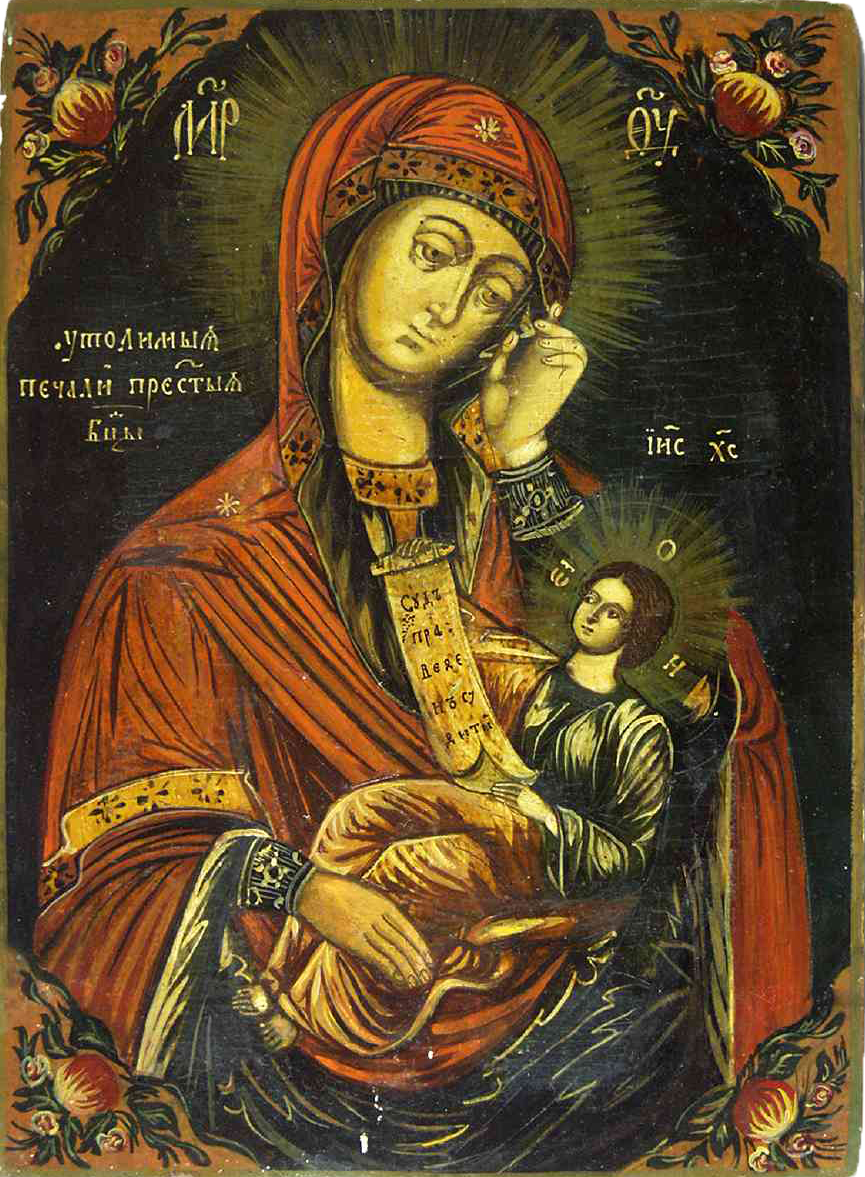
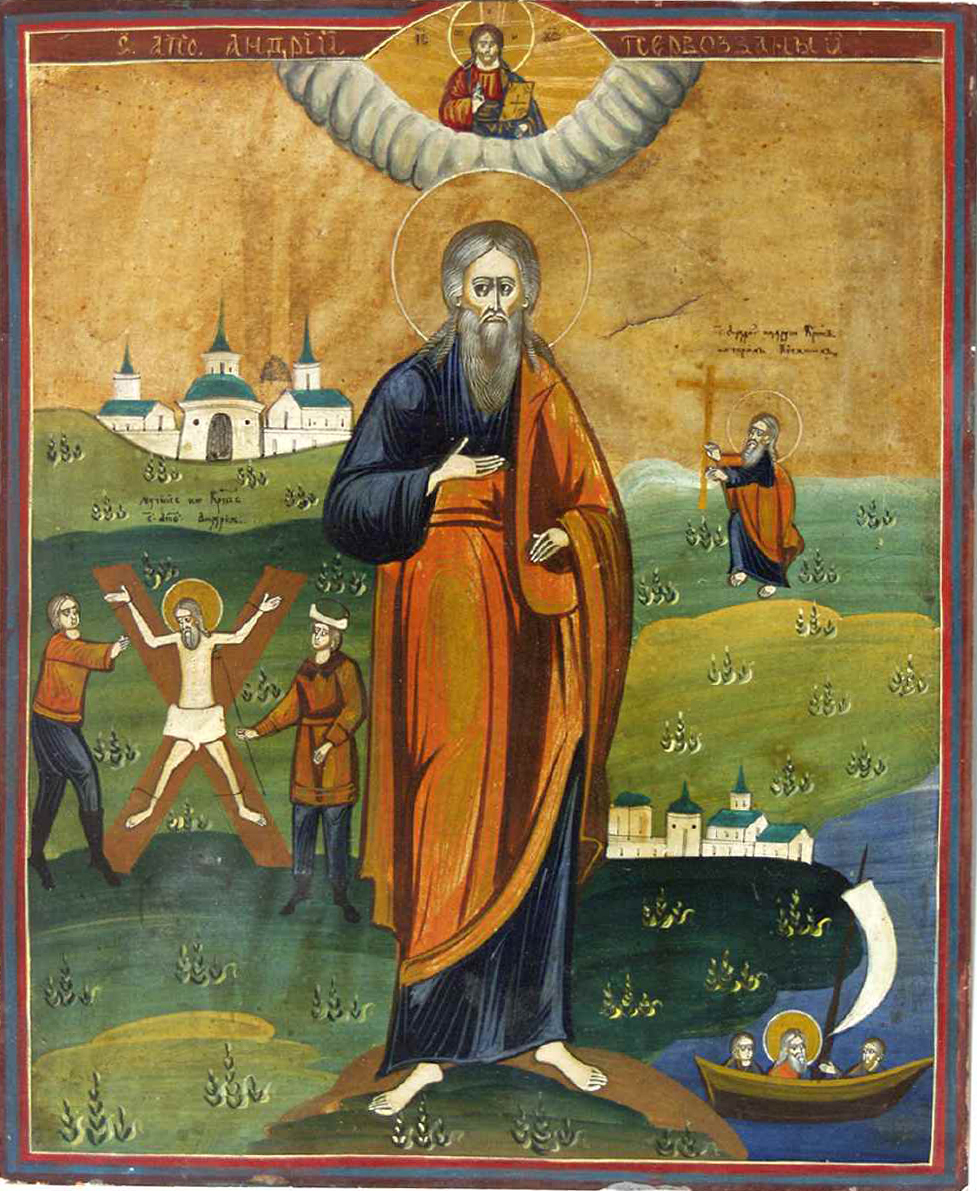
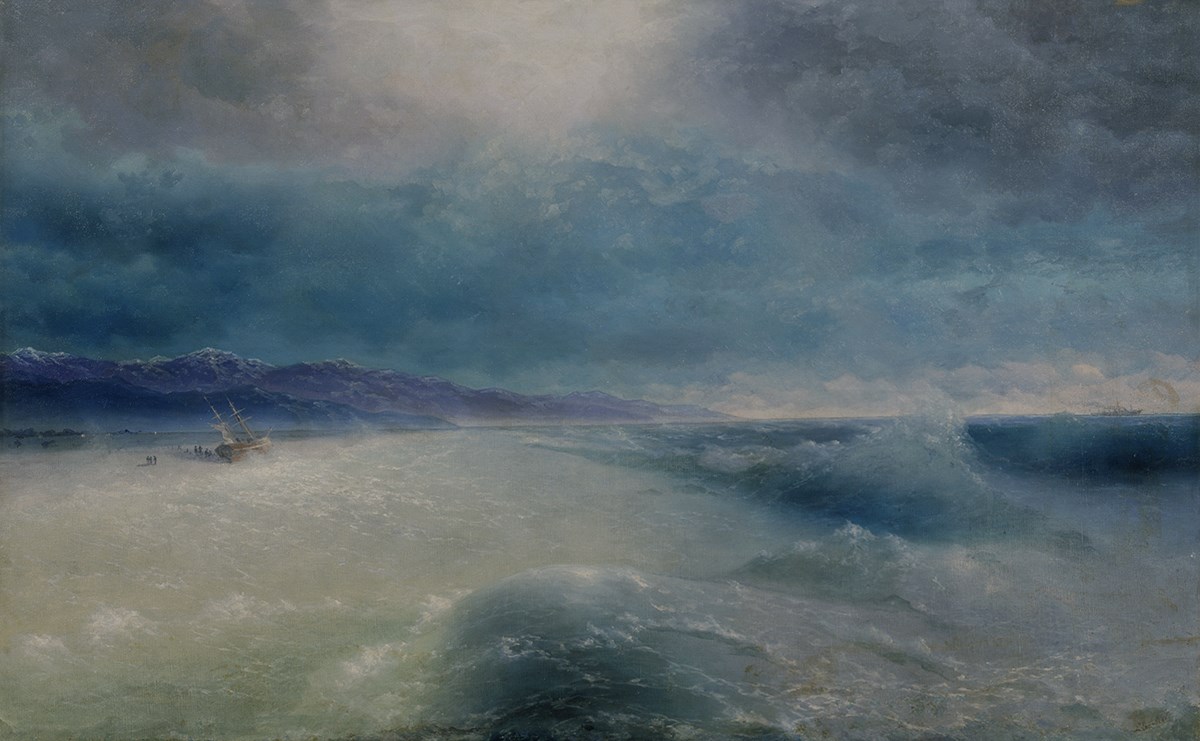
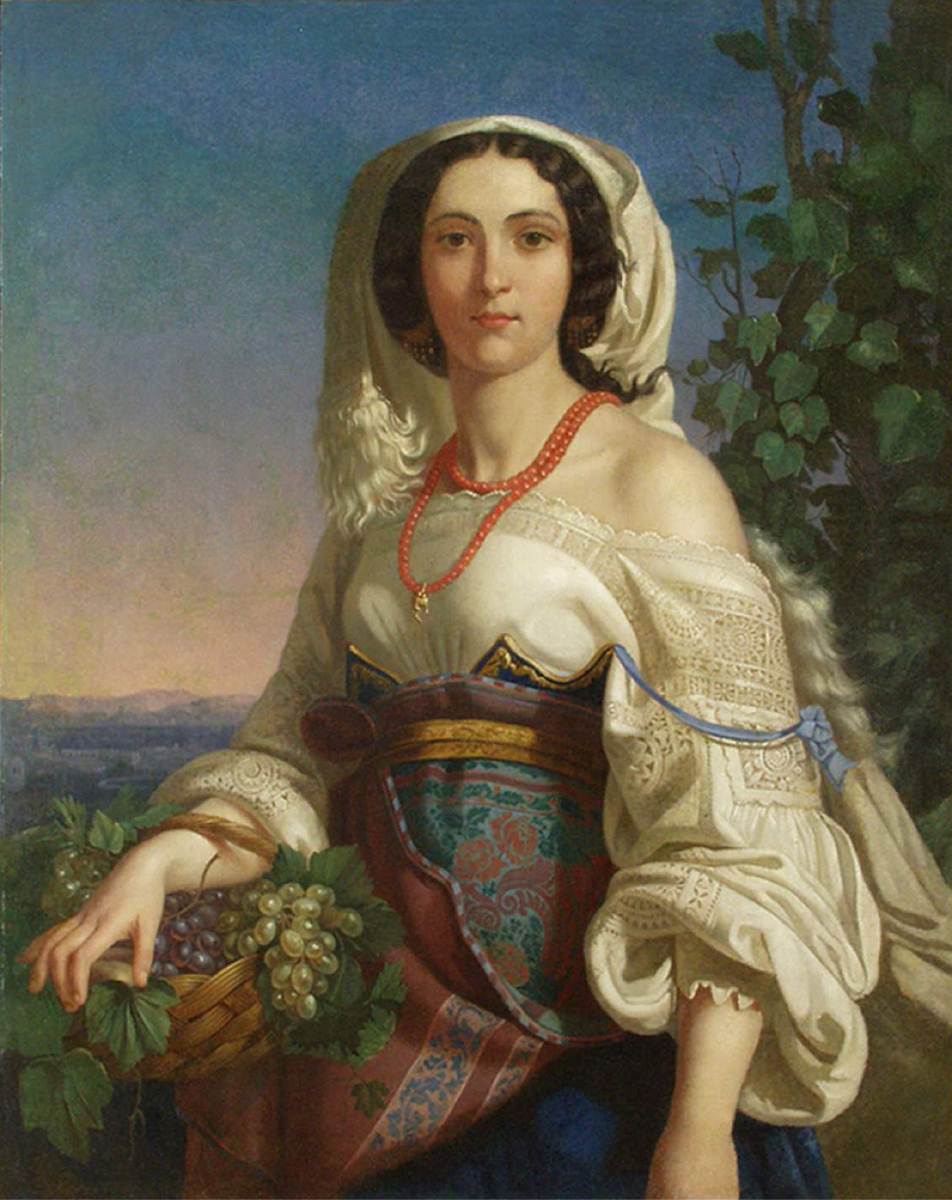

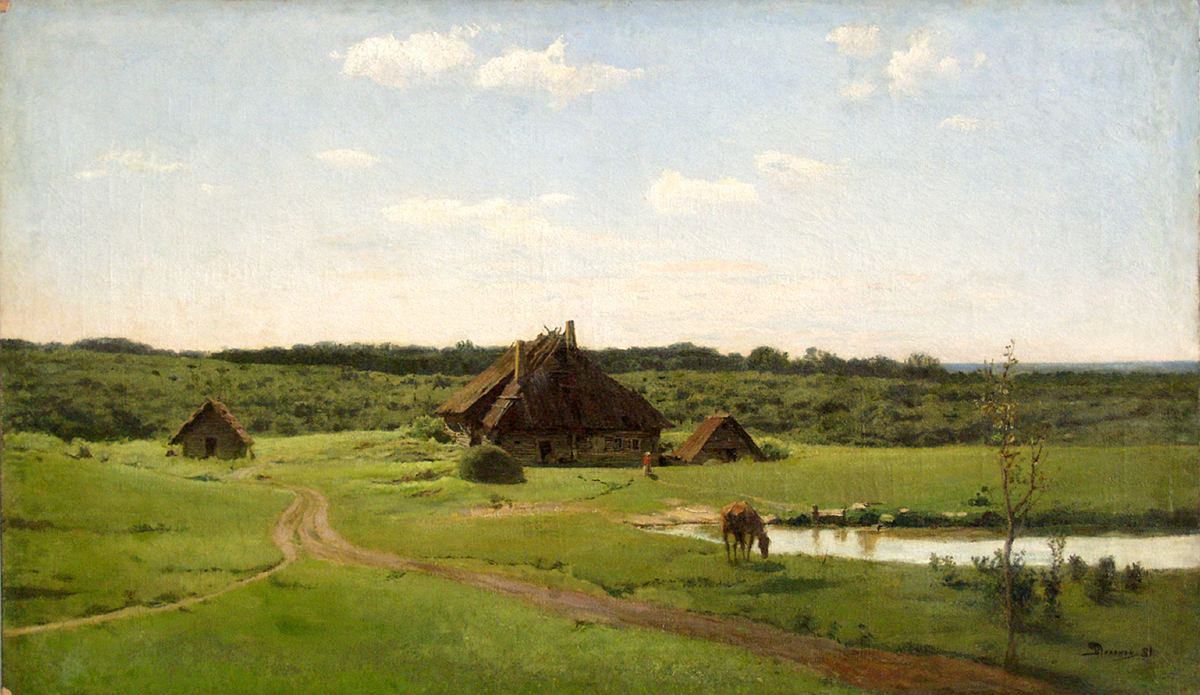
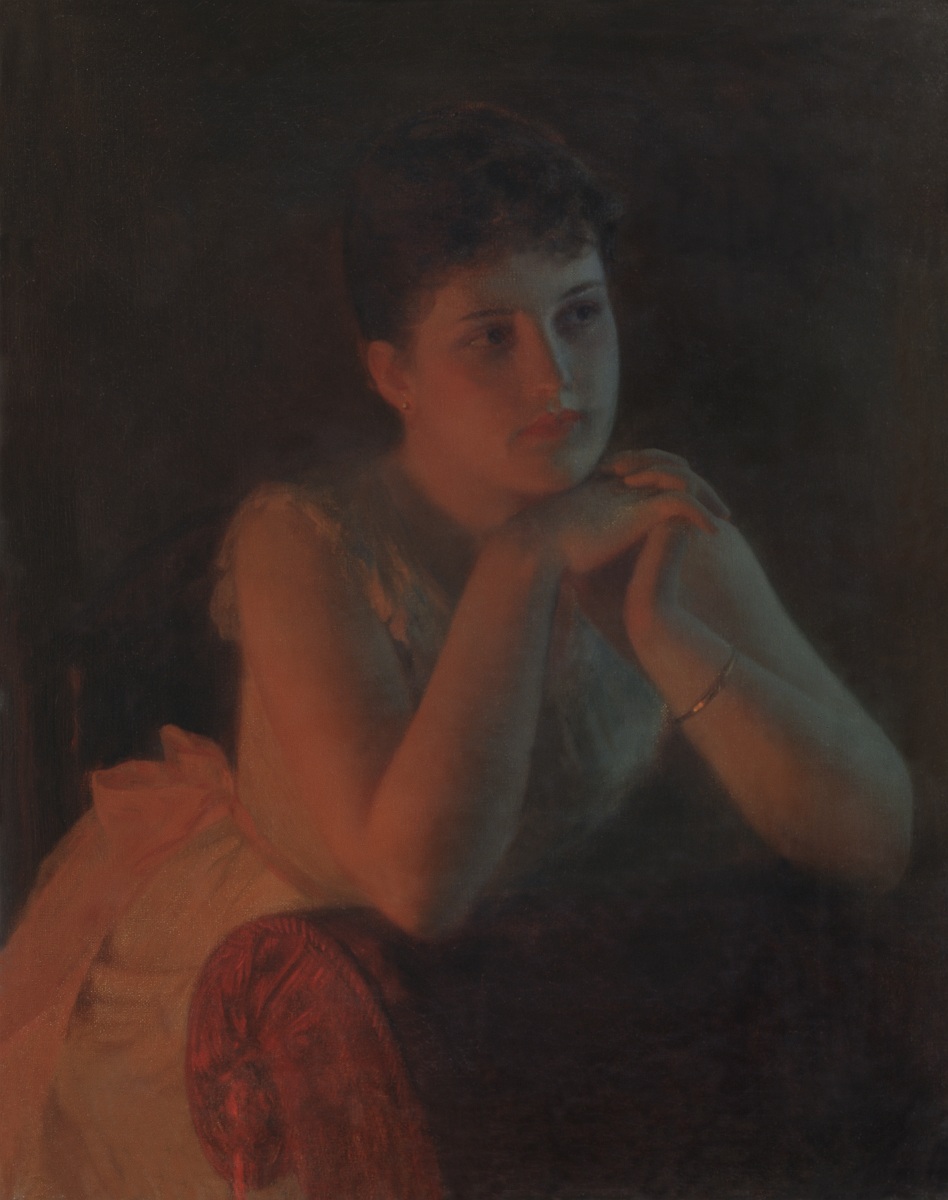
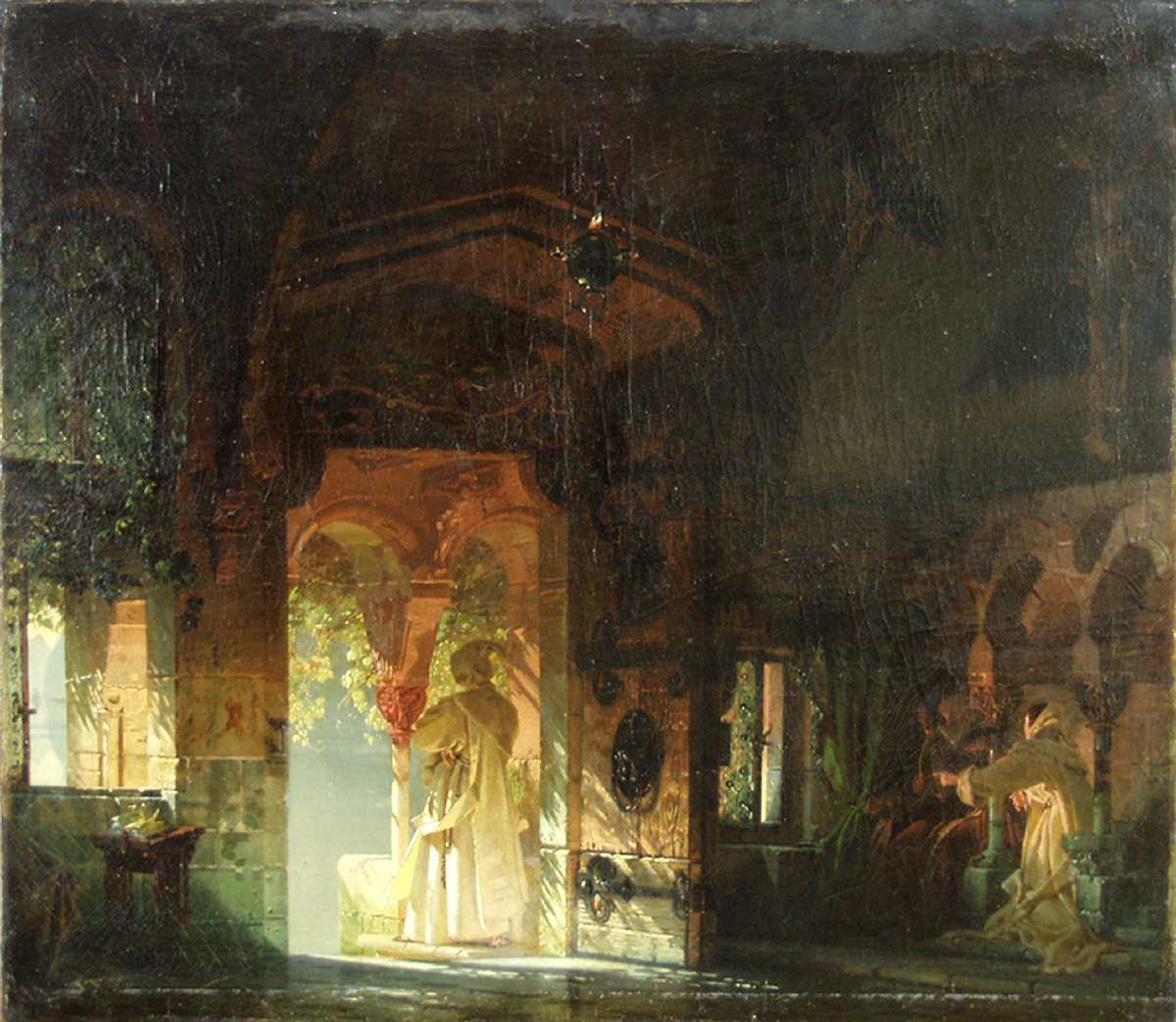
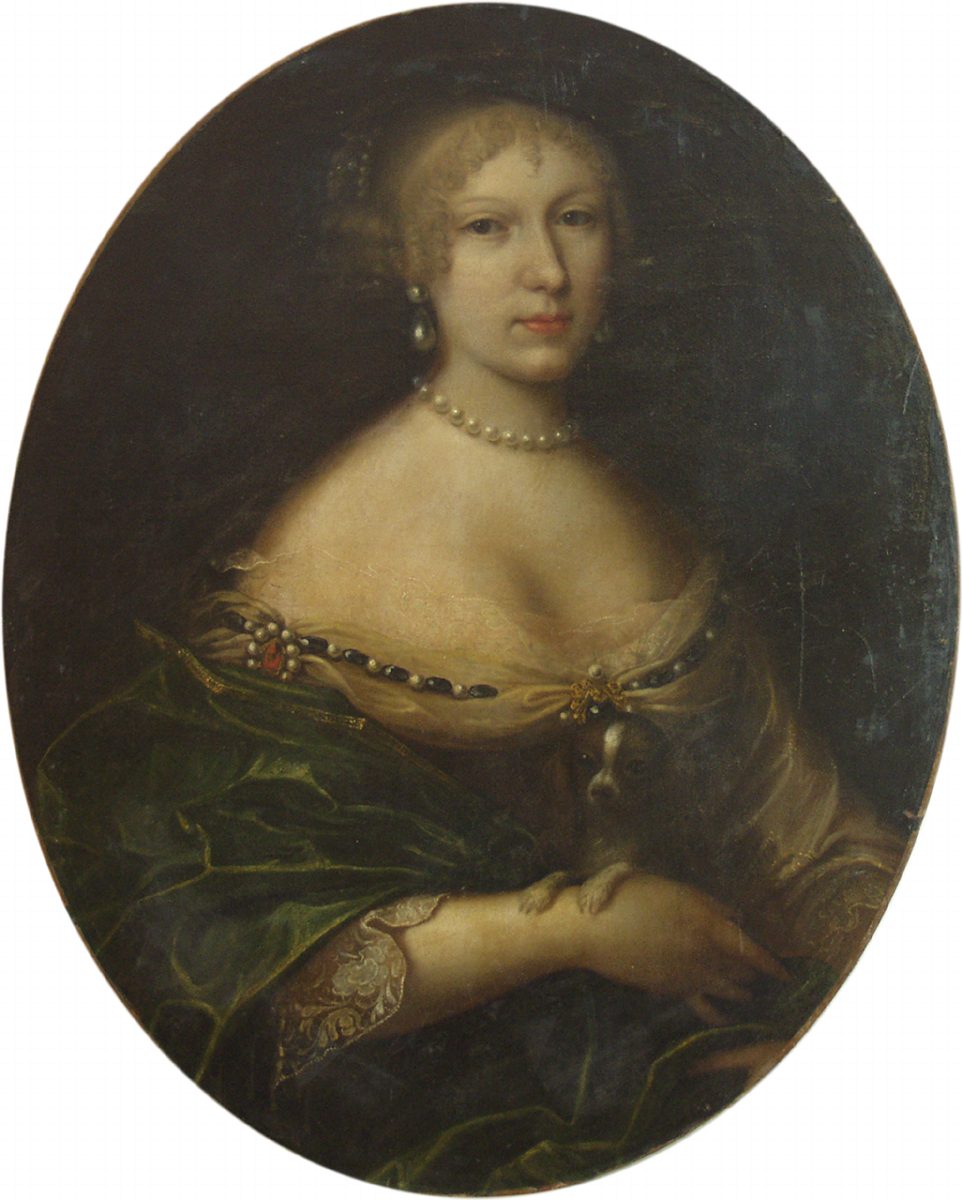
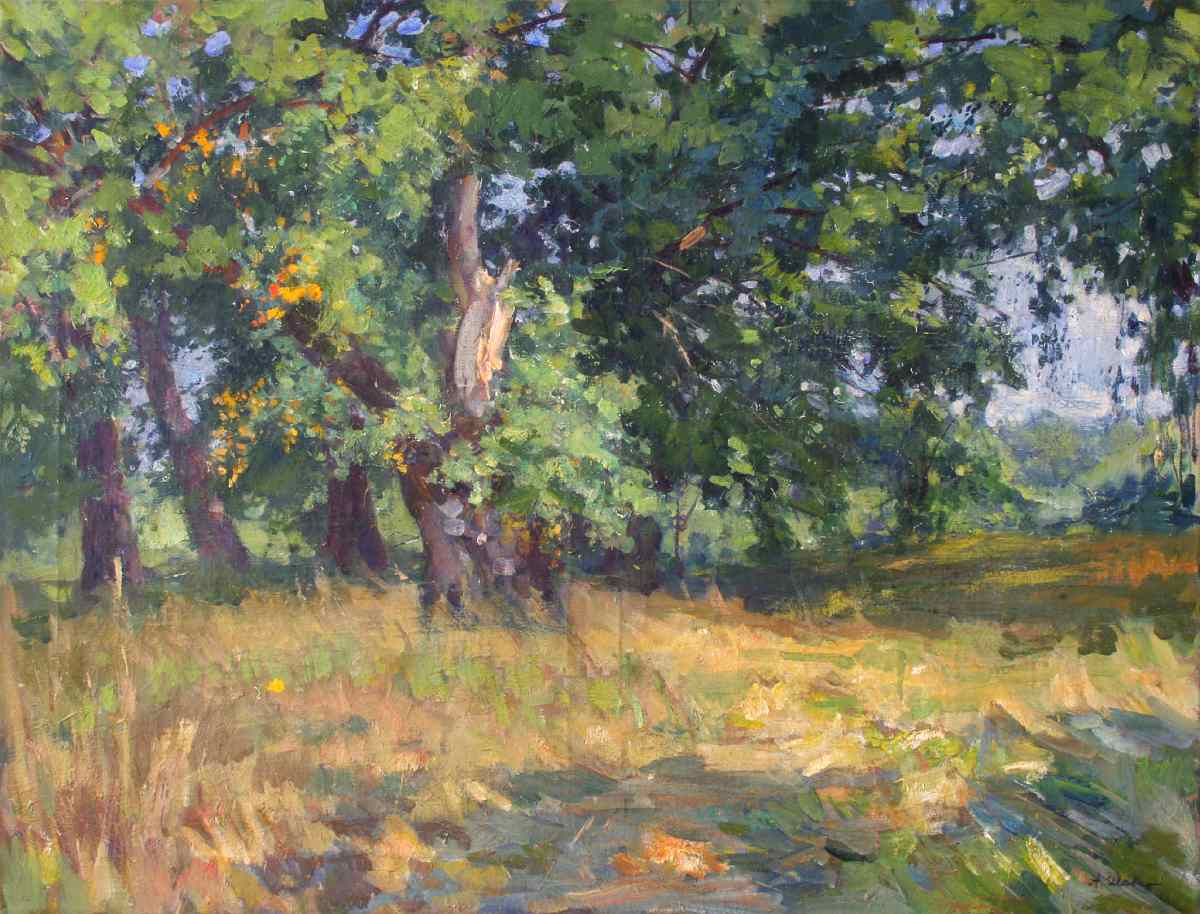
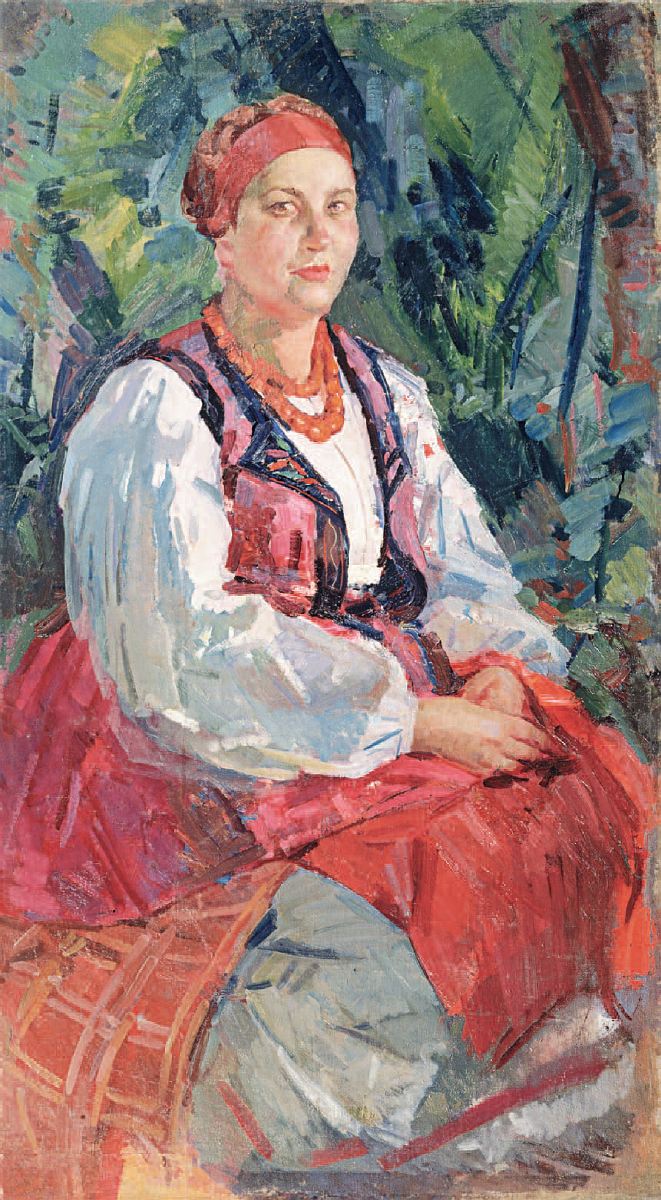
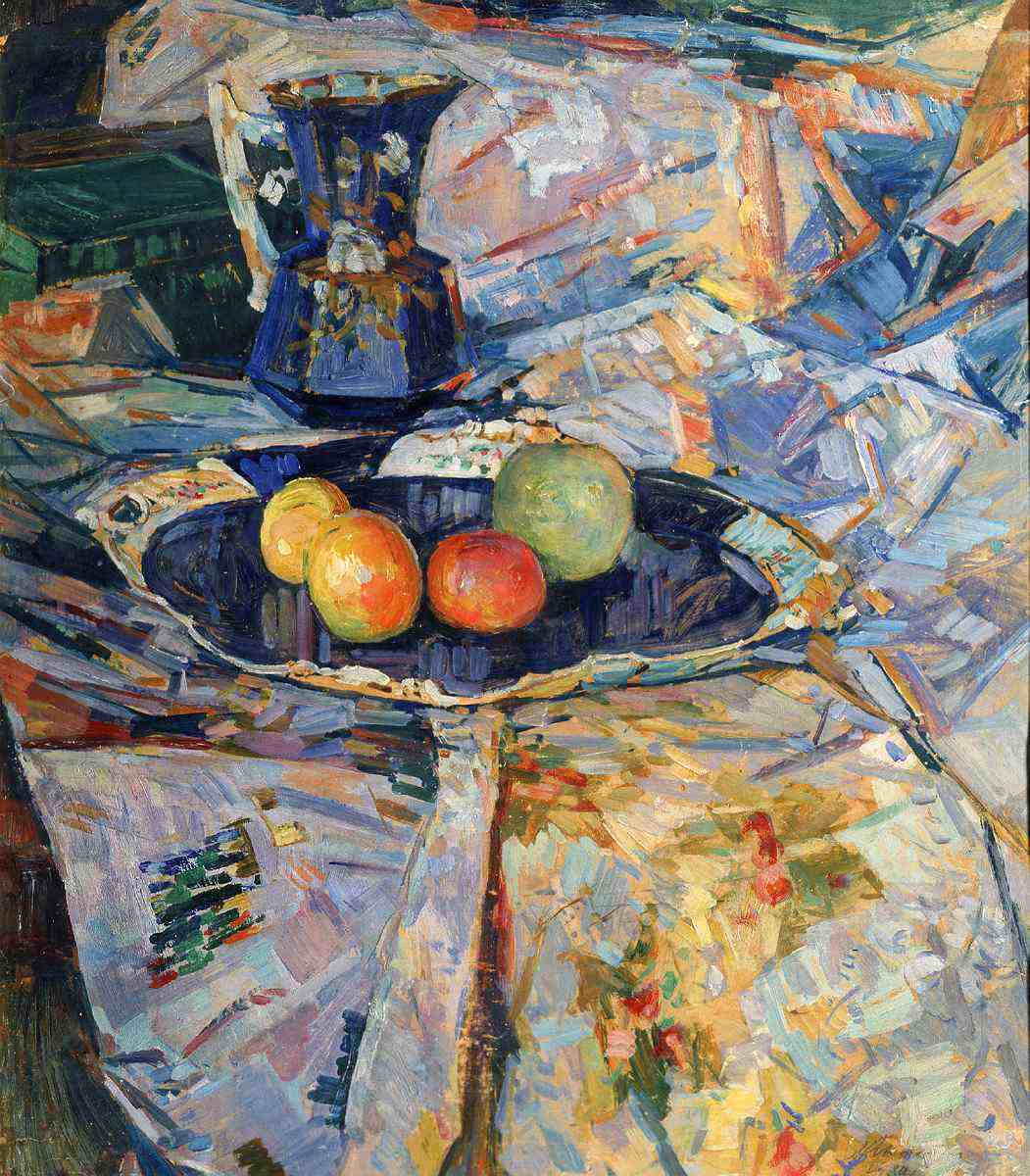
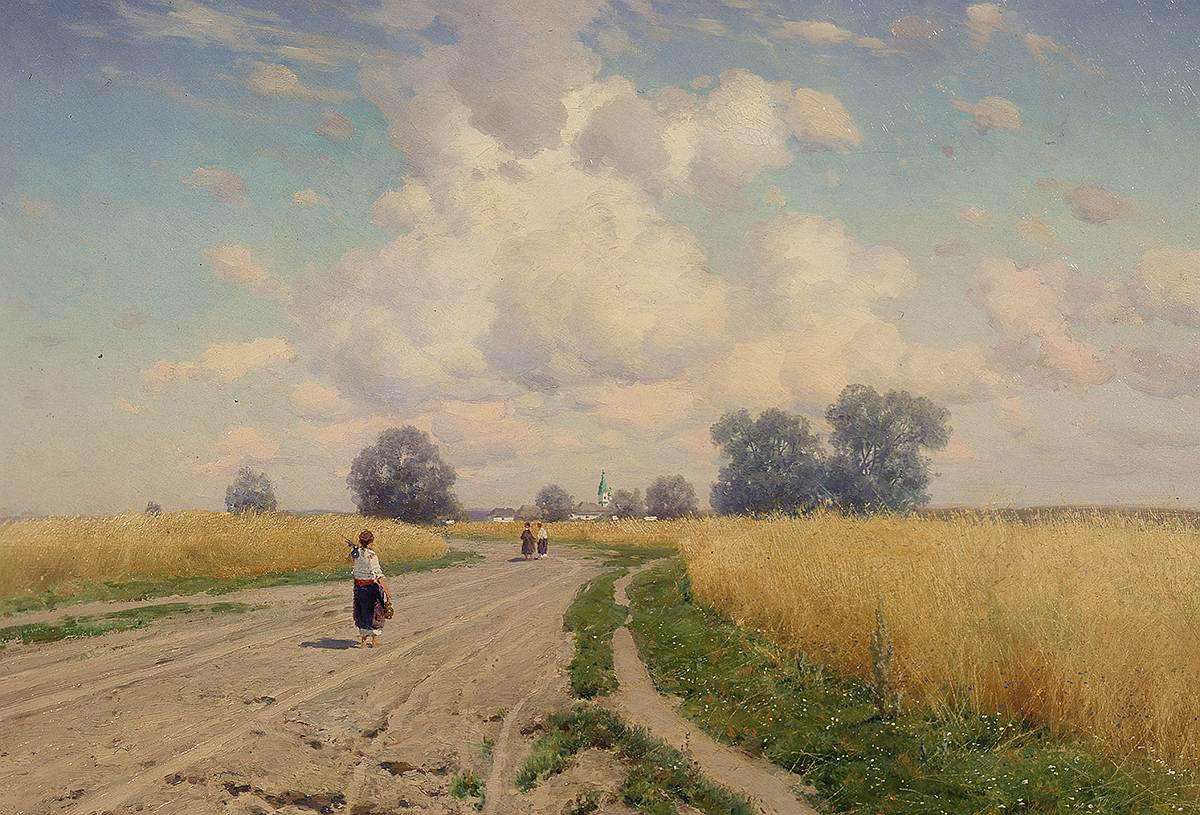

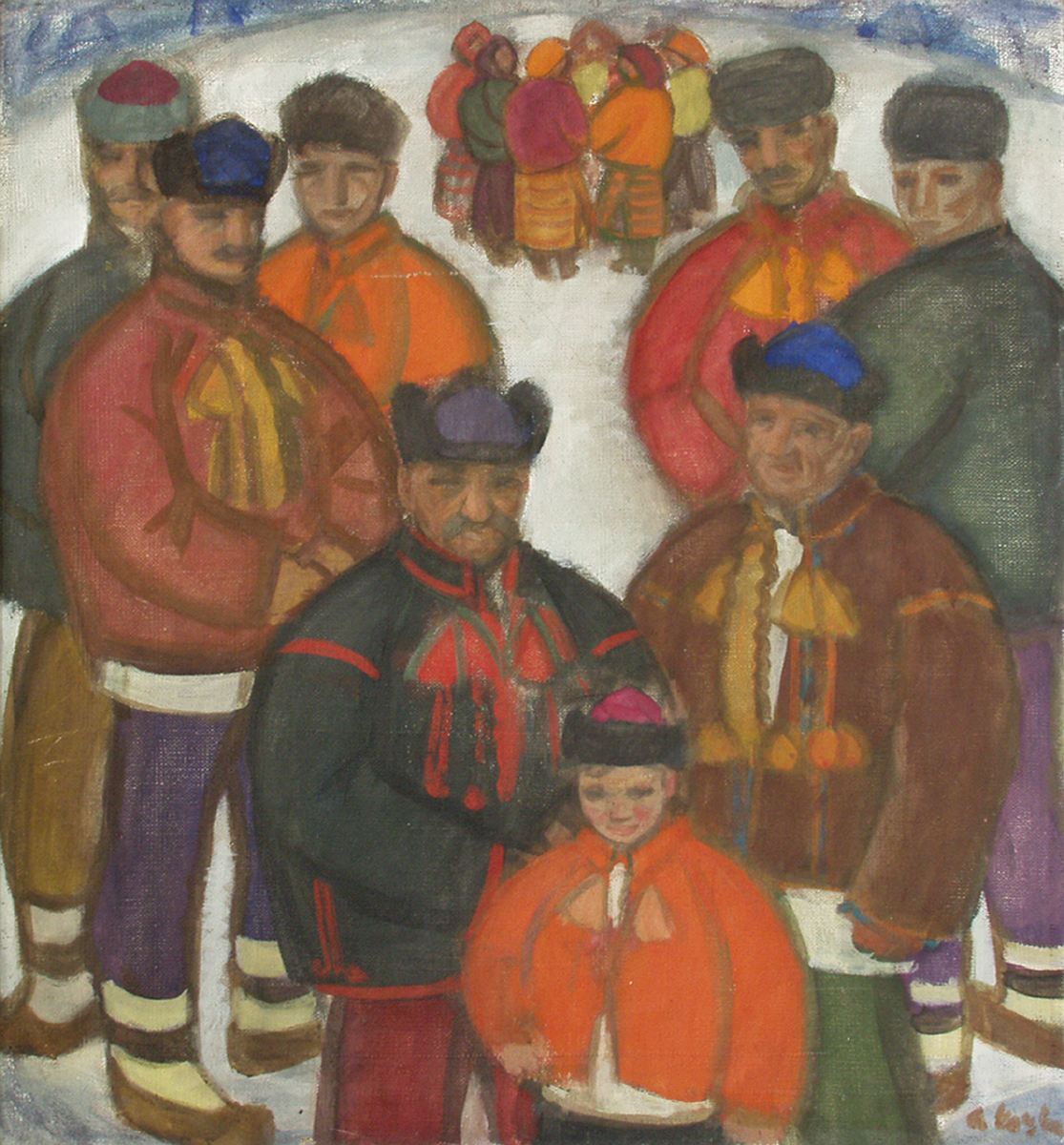
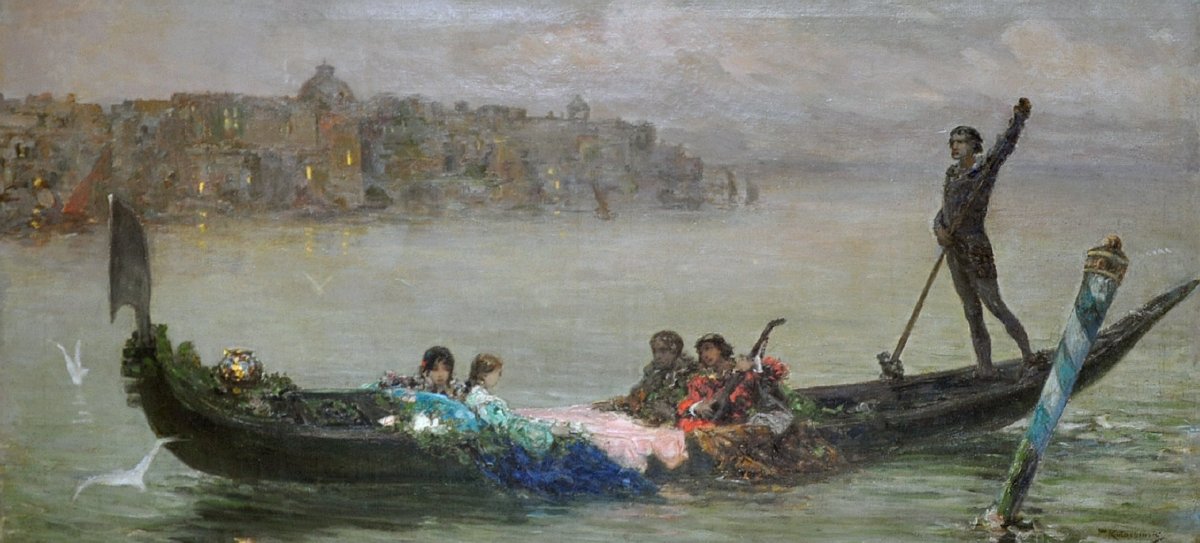
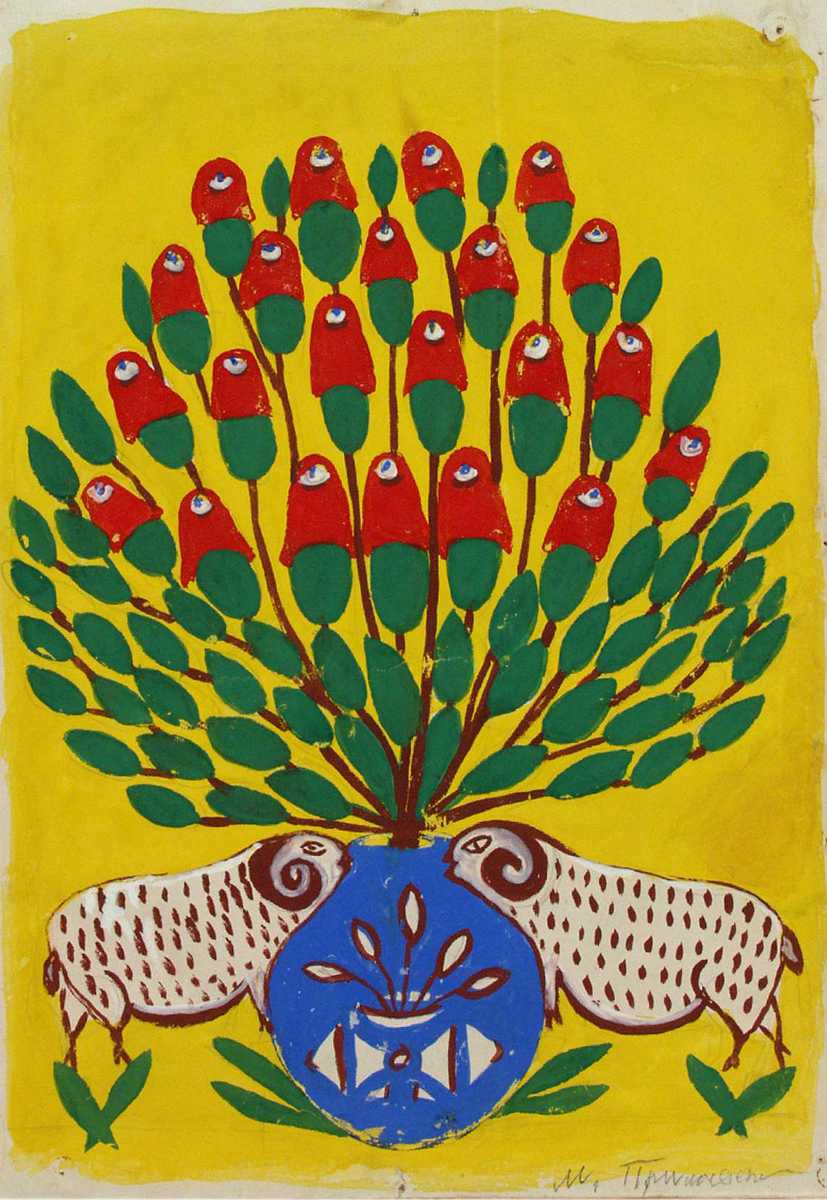
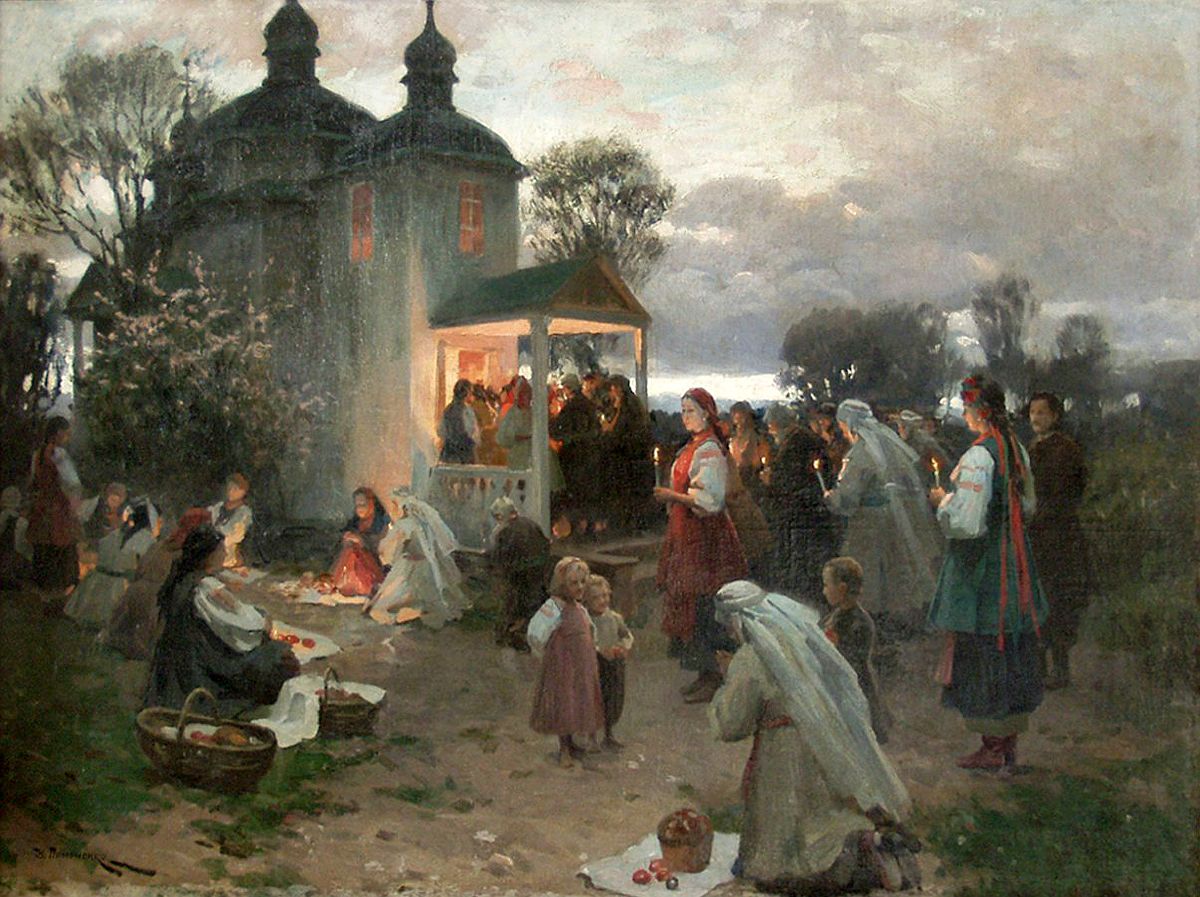
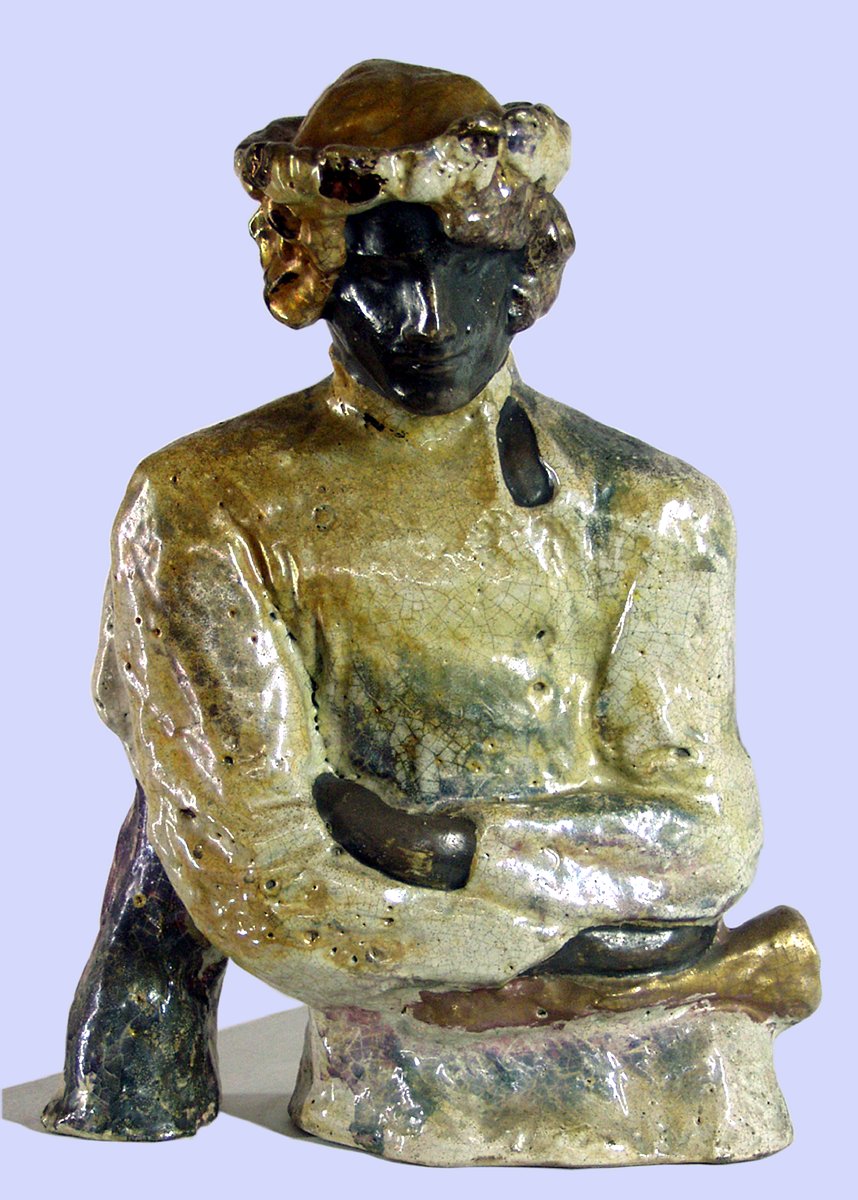
Although the museum’s director was forced to leave the city, some of the museum’s staff remained in Kherson. They periodically came to the museum to look after the works of art in the storage room and to monitor the situation in the Kherson Regional Museum of Local Lore, which is located nearby.

Andrey Malgin
According to Alina Dotsenko, the Russian military came to inspect the art museum several times during the occupation, but they became significantly more active just before the Ukrainian army’s offensive in autumn 2022. Andrii Malgin, director of the Central Museum of Tavrida in occupied Simferopol, came to Kherson on the last day of October. He was accompanied by other people, one of whom was identified by museum staff as Oleg Shkedia, Malgin’s deputy. Together with the military, these people inspected all the museum’s premises and went down to the storage room where the paintings and sculptures were kept.
Under the direction of representatives of the Crimean museum, about a hundred workers and military personnel spent four days loading valuables, including paintings belonging to the Kherson Regional Art Museum, into trucks and buses. On the last day, they even took the computers.
The vehicles used by the Russians to transport the stolen goods to Crimea had their licence plates removed. Residents of Kherson, who were passing by the museum, filmed the robbery.
Trucks, some of them marked with the signs “MES of Russia” Ministry of Emergency Situations of the Russian Federation), and yellow school buses.
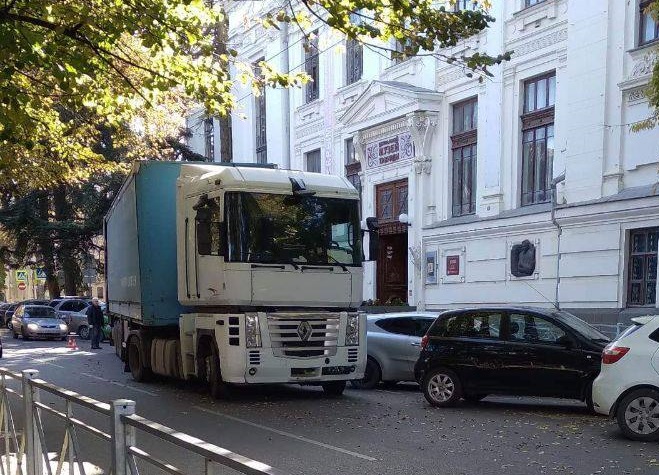
A truck without licence plates, which was used to transport museum valuables from Kherson to the Central Museum of Tavrida in Sevastopol (photo provided by Alina Dotsenko)
The occupiers took almost the entire collection of the Kherson Art Museum to Crimea. In August 2023, pro-Russian mediareported on some agreements of the occupation ‘Ministry of Culture of the Kherson region’, according to which the collection would be stored in Crimea ‘for the period of the conflict’. A story by the Tavria TV channel makes it clear that at that time the paintings were kept in the concert hall of the Central Museum of Tavrida. But a year has passed, and it is unknown whether the paintings are still there and in what condition.
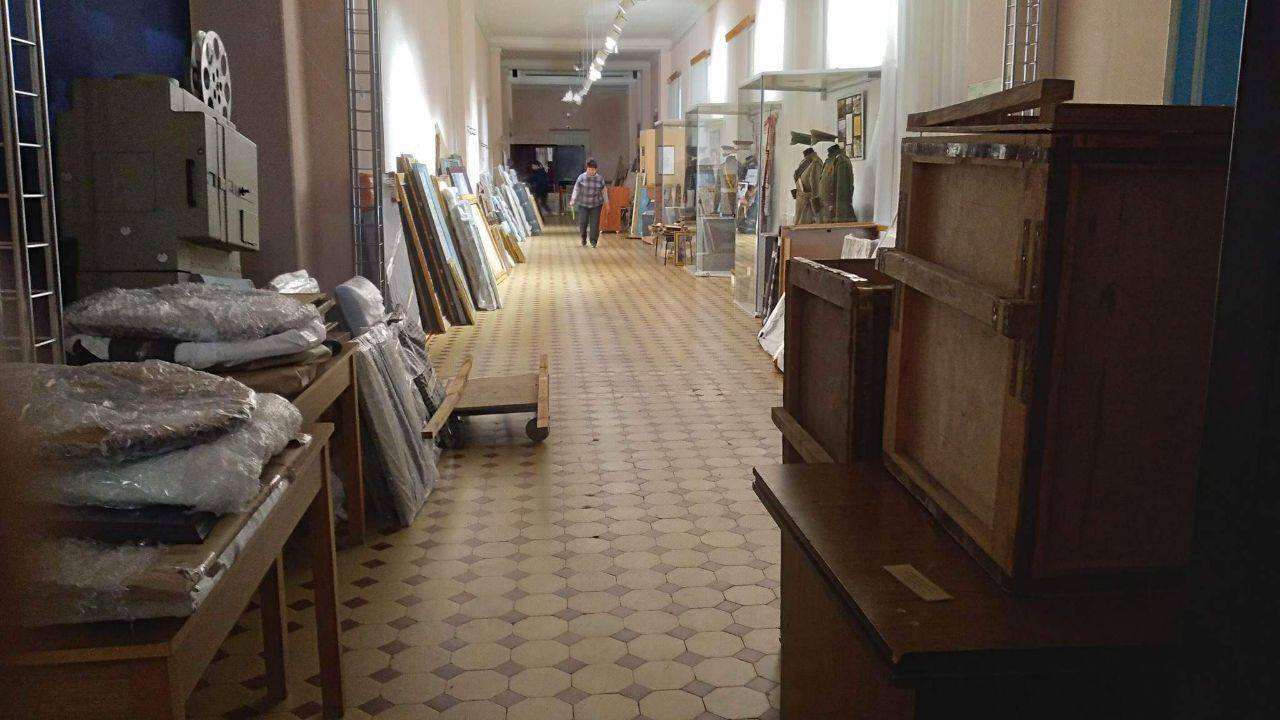
The stolen paintings from the Kherson Regional Art Museum were unloaded at the Central Museum of Tavrida in Simferopol (photo courtesy of Alina Dotsenko)
By the way, it was thanks to the stories on Russian TV channels that Ukrainian museum workers were able to identify the stolen paintings. They were able to identify 121 paintings which are presently in the Simferopol museum in the video,
As for the Kherson Regional Museum of Local Lore, at the time of the invasion, the museum’s collections contained more than 170,000 items, and the museum’s exhibition had about 10,000 exhibits. The museum’s director, Tatiana Bratchenko, 74, immideately started collaborating with the Russians, and will soon be tried in absentia in Ukraine.
‘We can say that there was a centre of Russian culture there. Collaborators, the commandant’s office, and their prosecutor’s office gathered there. They were throwing their parties there. And the director of this museum did not hide it, she always said how much she was waiting for Russia, how glad she was to see them,’ describes the situation in a neighbouring museum Alina Dotsenko. “Our museum also had collaborators among its staff, albeit in the minority. We knew about their views, and it was difficult to work with them. But there was no one else to work for such small salaries, so we had to tolerate it.”
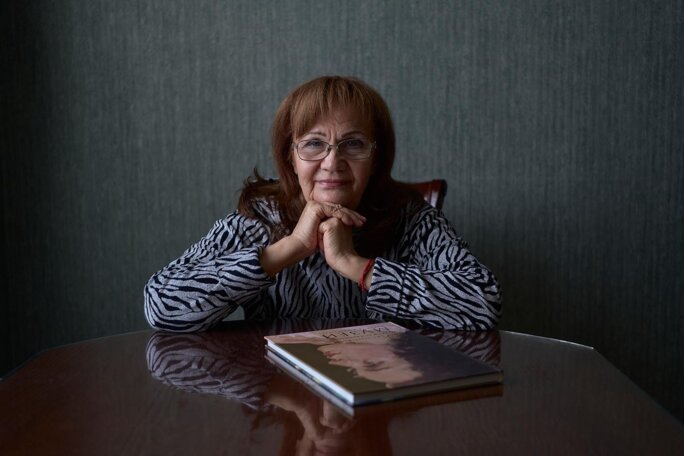
Aline Dotsenko (photo by the Kherson Regional Art Museum)
Tetiana Bratchenko now lives in Russia, to which she left during the Ukrainian army’s counter-offensive. Even before that, the Russians replaced her as the museum’s director with another collaborator, an employee of the museum’s historical department, Tetiana Shandra, who is also under investigation in Ukraine.
NGL.media managed to speak briefly with Bratchenko during the preparation of this material, claiming to be journalists from the Russian Federation. She claims that she was not in Kherson during the ‘evacuation’ of the museum’s valuables. “We just went to St. Petersburg for two weeks because my husband had to have an urgent surgery,” Bratchenko said.
Unfortunately, it was not possible to get more information from Bratchenko: she stopped talking to us.
“I still don’t know where the collections are”
The Russians took almost everything of value from the local history museum, including golden antique jewellery, ancient weapons, artworks of past centuries, and artefacts related to Russian historical figures such as Suvorov, Ushakov and Potemkin. Fleeing Kherson, they dismantled and took away their monuments, and broke Potiomkin’s tomb in St.Cathrine’s cathedral to take his remains.
“They stole weapons, coins and took tablets from our lapidarium A lapidarium is an exhibition of ancient writing on stone slabs, including tombstones that belong to the Bosporus Kingdom, which was located near Kerch in Crimea This shows that they were interested in the history of Crimea,” Olha Honcharova, who was appointed director of the museum after the de-occupation of Kherson, tells NGL.media.
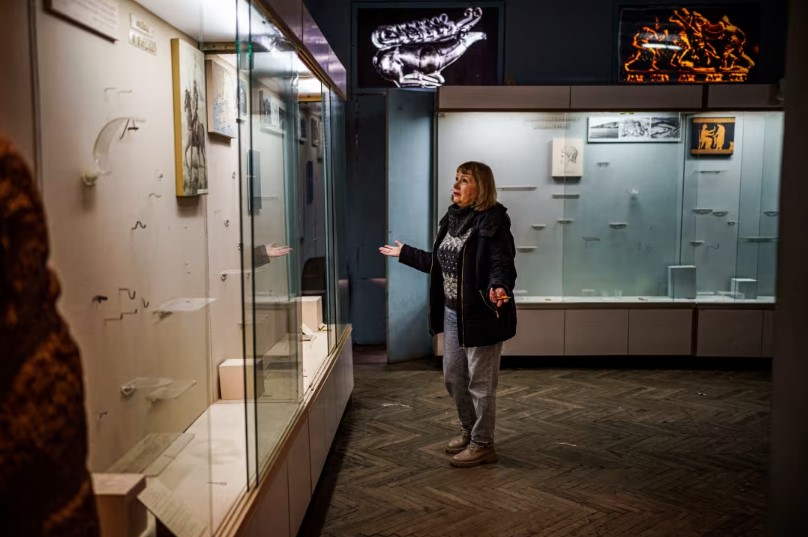
The current director of the Kherson Regional Museum of Local Lore, Olha Honcharova, stands next to empty shelves in one of the halls of the Kherson Regional Museum of Local Lore (photo by NBC News)
According to the museum’s security guards, the theft of the exhibits lasted for two days. The items were taken away in three trucks without licence plates, and were carried out by about 70 people who, according to the museum, were brought from Crimea. During the two days of work in this museum, the Russians managed to remove almost the entire exhibition. but did not have time to get to the storage space containing the vast majority of items from the collections.
In February 2023, the collection of the local lore museum dedicated to Suvorov was taken to occupied Henichesk, where it was shown to local schoolchildren. The destiny of the other museum exhibits of the local lore museum is unknown. There was information that they were stored in the Chersonese Tavriya Museum-Reserve in Crimea, but there is no evidence that the exhibits are now there, especially since there is periodic informationabout taking collections out to Russia from the reserve itself and suspicious excavations on its territory.
NGL.media, posing as a Russian journalist, contacted Elena Morozova, director of the Chersonesos Tavriya Museum-Reserve, with a request to help organise filming about the “evacuated and rescued collection from Kherson”. When the woman heard the word “Kherson”, she literally started screaming and didn’t let the journalist finish her thought.
“I don’t understand what you’re talking about! I don’t discuss such things on the phone! Please be so kind and make official requests! Let’s end this conversation!” Morozova shouted and ended the call.
Morozova wasn’t the only one with a strange reaction. Andrei Malgin, the director of the Central Museum of Tavrida, who personally led the ‘evacuation’ of museum exhibits, was clearly afraid to talk about the events of November 2022.
Would the heads of the Crimean museums have reacted the way they did if they did not realise that they were involved in the crime?
NGL.media also tried to find out which Russian officials could have been directly involved in the removal of cultural property from Kherson museums.
For example, the deputy director of the Department of State Protection of Cultural Heritage of the Ministry of Culture of the Russian Federation this department ensures the protection of cultural property and monitors compliance with legislation in the museum sector, including the registration of exhibits in the catalogue of the Museum Fund of the Russian FederationDenis Protsenko participated in the interregional forum “Preservation of Cultural Heritage. Achievements and Experience of the Regions” at the end of 2023. which took place in the occupied Sorokyne formerly Krasnodon; in 2016 the city was given back its historical name Sorokyne. Here Protsenko taught museum workers from “new regions” Russia’s name for the occupied territories of Ukraine, including the Kherson region how to transfer museum property into the Russian legal framework.

Denis Protsenko (VK photo)
In a conversation with NGL.media we posed as journalists from Russia Protsenko assures us that the ‘new regions’ came under the jurisdiction of his department only in March 2024. According to Protsenko, at the time of the ‘evacuation’ of museum property from Kherson, the process was overseen by employees of the Department of Museums and External Relations.
“I personally found out that the collections had been evacuated a year later during a personal conversation with the Minister of Culture of the Kherson region. All the questions you raised were the responsibility of the Department of Museums and External Relations of our central office. I still don’t know where these collections are, what was taken away, where and how it is distributed,” says Denys Protsenko.
The Department of Museums and External Relations of the Russian Ministry of Culture that Protsenko is referring to is headed by Elena Kharlamova, whom we were unable to contact. Instead, her deputy Natalia Chechel agreed to talk about the cultural property taken from Kherson only with the permission of the ministry’s press service: “You see, we have a strict discipline here and any comments are made only after official approval.”
After this short conversation with the pseudo-Russian journalist, Natalia Chechel removed her photo from the Telegram chat and stopped making contact. Other employees of the ministry, whom we tried to contact from the Russian number, behaved in a similar fashion.
However, we have identified employees of the Russian Ministry of Culture responsible for taking out Ukrainian cultural property and registering it under Russian law. Though these people did not take the artefacts from Ukrainian museums with their own hands, they are directly involved in their appropriation by Russia.
What exactly have we lost?
According to the information from the Ministry of Culture provided at the request of NGL.media, Russians took 10,170 items from the Kherson Regional Art Museum, including paintings by famous Ukrainian and European artists and many other works of art. However, neither the museum management nor the Ministry of Culture can currently provide an exact figure for the stolen items from the Kherson Regional Museum of Local Lore: The museum did not keep an electronic catalogue, but paper books of acquisition accounting document with descriptions of all museum items. The Russians took it along with the exhibits. According to the museum’s director, Olha Honcharova, the museum staff is now trying to restore the lists of exhibits at least partially.
There are currently 62 museums in the occupied territories, with a total of over 1,400,000 million exhibits This is the figure provided by the current Minister of Culture Rostyslav Karandieiev, but it is most likely provisional, as the documents describing the collections of the occupied museums have in most cases remained in place. It is very difficult to track the condition of the collections of these museums, as either collaborators remained in the management of the occupied institutions or the Russians appointed their proxies, who, of course, do not provide Ukraine with any information about cultural property.
The full list of stolen items from the Kherson Art Museum
Since the list includes more than 10,000 objects, we have “hidden” them in a table with a search bar. You can search by name, author, type, or just browse the list page by page
| Автор | Опис |
|---|
Failed evacuation
Russia is primarily to blame for the loss of cultural property, or more specifically, certain people we named above and many more unidentified war criminals. During the looting of museums, the Russians tried to be inconspicuous. That’s why they did not introduce themselves, hid their faces, and arrived by transport without identification marks.
Proving the guilt of specific Russians, punishing the perpetrators and returning the loot is not easy, and it may take decades of hard work by international law experts, the public and politicians. That is why it is worth analyzing the situation now (and, in fact, much earlier) and working to ensure that we, Ukrainians, do not lose our cultural heritage anymore.
So why didn’t we evacuate cultural property before the full-scale invasion? After all, there was the experience of 2014, when the Russians occupied Ukrainian territories and appropriated museum exhibits and other cultural objects along with them. As a result of the annexation of Crimea alone, we lost 31 museums containing almost 930,000 items from the state part of the Museum Fund of Ukraine. For 10 years, the Russians not only did not return a single valuable item to Ukraine, but also managed to add our valuables to their state museum fund, thus trying to legalize the loot.
Evacuation of cultural property is regulated at the legislative level by a government decree. Both lawyers and museum managers NGL.media spoke to complain that the existing evacuation procedure is not practical. And that is why the evacuation of cultural property has been and still is chaotic.
“Over the past few years, representatives of the ministry and regional authorities have repeatedly asked us to provide lists of museum objects for evacuation, and we complied. But the fact is that most of the items were in exhibitions, and to disassemble the exhibition, time, equipment and packaging material are needed, and no one provided those. The evacuation should have been planned thoroughly, but it existed only on paper for many years,” says Olesia Milovanova, a member of the Museum Crisis Center initiative “The Museum Crisis Center is based in Lviv and helps museums from the occupied and dangerous regions and their staff), director of the Luhansk Regional Museum of Local Lore and director of the Luhansk Regional Museum of Local Lore until 2014, the museum was based in Luhansk, but after the Russians seized the museum, it resumed its work at the local lore museum in Starobilsk, 100 km from Luhansk. In 2022, Starobilsk was occupied, and the museum lost its collection for the second time).
In the fall of 2022, the former Minister of Culture Oleksandr Tkachenko also spoke about the imperfection of the system and stated, that before the invasion, Ukraine had no effective mechanism for the preventive evacuation of cultural property whatsoever. He accused local museums, particularly in Mariupol, of refusing to evacuate on their own In March 2022, an air strike on Mariupol destroyed the local history museum, which also housed the main collection of the Archip Kuindzhi Art Museum in Mariupol, where original paintings by Mykola Hlushchenko, Tetiana Yablonska, and other prominent artists were kept. The paintings burned down with the building. Russians claim that some of the paintings, including those by Arkhip Kuindzhi himself, were rescued by museum staff and are now stored in the Donetsk Regional Museum of Local Lore, which is also under occupation).
In the case of Mariupol, the director of the local lore museum, Nataliia Kapusnikova, turned out to be a supporter of the occupation, which fully explains her reluctance to evacuate the museum. However, the experience of other museums that were in danger of losing their valuables shows that even those with the most pro-Ukrainian position, really willing to save their collections, encountered problems.
Thus, remembering how the Russian invasion of the Luhansk Regional Museum of Local Lore ended in 2014, the museum’s director, Olesia Milovanova, prepared for the evacuation shortly before February 24 without waiting for instructions from above.
“About a week before the invasion, we started dismantling the exposition, and I ordered other museums in the regions to do the same. All of it was happening spontaneously. We had no designated evacuation point, so I made an agreement with Lviv, with the Territory of Terror, museum, our long-term partners, at my own discretion,” Olesia Milovanova recalls..
The heads of a number of other Ukrainian museums took on this responsibility for the rescue of exhibits, and some were saved. However, in the case of the Luhansk museum, there was not enough time to evacuate the collection, as the hostilities started before the evacuation vehicles arrived.
It is important to understand that the cultural property kept in Ukrainian museums is part of the State Museum Fund of Ukraine. The district and regional administrations, which are responsible for communicating the ministry’s orders and instructions to museum directors, are a separate link in the communication between museums and the Ministry of Culture. The directors, in their turn, have to ensure that these orders are implemented, and in the case of evacuation, this means taking responsibility for the removal of thousands of exhibits, solving logistical issues, finding people, and keeping all valuables in good condition. Amidst the war, not everyone is ready to do this.
“Our evacuation instructions are very outdated and ineffective, and they should have been revised long ago. Because now stipulates that while museum workers are hiding from bombardments, with missiles flying around, they are supposed to draw up a pile of documents, and write all the commas and dots correctly to save these objects. And they make a mistake, they will be prosecuted,” Olesya Milovanova also complains about the excessive bureaucracy.
The current Minister of Culture Rostyslav Karandieiev Rostyslav Karandieiev was appointed acting Minister of Culture in July 2023, before that he worked as a deputy minister last year announced the creation of a unified electronic register of the Museum Fund of Ukraine. This was supposed to help Ukrainian museum workers keep records of their collections; the state to understand what is happening to these collections; and international law enforcement agencies to quickly identify artefacts taken from Ukraine on the black market. So far, this all sounds like a dream.
In April 2024, Rostyslav Karandieievsaid that the construction of new storage facilities for museum exhibits would soon begin. However, for now, museums continue to be evacuated according to the old scenario by museum workers, international organizations that help with packing, and personal arrangements. “In general, the situation has not changed much since 2022,” says Olesia Milovanova.
The Ministry of Culture refused to provide information to NGL.media on the status and pace of evacuation of cultural property from dangerous regions, considering it proprietary information. As of June 2024, the Ministry of Culture reports 250,000 museum objects that have been evacuated to safe places.
The Ministry of Culture also informed us that the construction of storage facilities for museum property requires design and additional funding. Simply put, this idea is still far from being implemented.
What are the chances of returning the stolen valuables?
Historical researchers believe that the chances of returning the treasures stolen from Ukraine are extremely low. After all, the taking out the cultural property for the occupiers is not only an opportunity to enrich their own collections or, in some cases, themselves, but also to distort the historical and cultural background and prove that all Ukrainian property actually belongs to Russia.
“Since the times of the Russian Empire, they have been taking out only the most valuable things and those that can confirm the common heritage of the entire so-called Rus, the Russian world. For example, they like and honor Scythian gold, as well as monuments from the times of the Kyivan state. They are trying to destroy everything that is the heritage of Ukrainian national art, Ukrainian national culture, and constitutes Ukrainian identity. During World War II, museums were also evacuated to distant regions of Russia. And then, too, not everything was evacuated, but only gold, NKVD archives, and the most valuable monuments that would also confirm this unity of peoples, the so-called Russian world,” historian Yaroslava Muzychenko explains to NGL.media.
She agrees with the theses of foreign researchers that the situation with the looting of Ukrainian museums also resembles the times when the Nazis plundered European museums. Ukraine, like other affected countries, is still returning the looted exhibits.
At the end of 2023, Vladimir Putin approved amendments to the law on museums and museum funds of the Russian Federation, which indicate that the Russians plan to continue their policy of appropriating Ukrainian culture. From now on, Russian law recognizes museum collections as integral and indivisible, prohibits the return of stolen cultural property and requires that they be included in the catalog of the Museum Fund of the Russian Federation as soon as possible. Objects and collections that are part of museum collections in the occupied territories must be cataloged by the end of 2027. By rough estimates Russia plans to register more than 44,000 Ukrainian artifacts, or, in other words, to legalize them.
So, obviously, the Russians do not intend to return the stolen artifacts. Nor do they intend to stop the destruction of Ukraine’s historical and cultural heritage. At least not voluntarily.
×
This material was prepared with the financial support from the European Union. The EU4IM project, funded by the European Union, is solely responsible for its content. The content of the material is the sole responsibility of NGL.media and does not necessarily reflect the views of the European Union.


